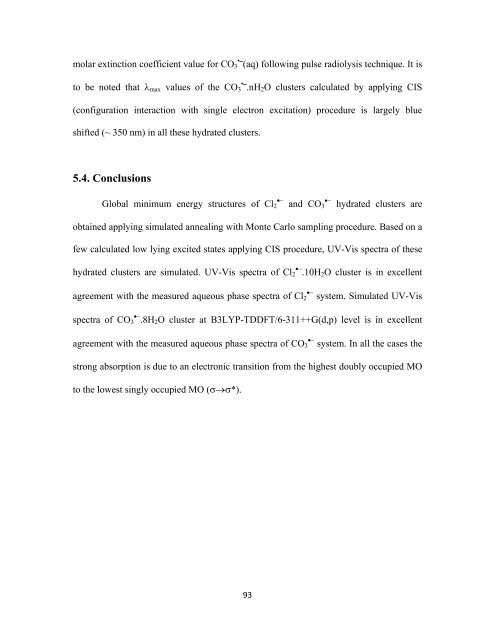CHEM01200604005 A. K. Pathak - Homi Bhabha National Institute
CHEM01200604005 A. K. Pathak - Homi Bhabha National Institute
CHEM01200604005 A. K. Pathak - Homi Bhabha National Institute
You also want an ePaper? Increase the reach of your titles
YUMPU automatically turns print PDFs into web optimized ePapers that Google loves.
molar extinction coefficient value for CO • 3 ⎯(aq) following pulse radiolysis technique. It is<br />
to be noted that λ max values of the CO • 3 ⎯.nH 2 O clusters calculated by applying CIS<br />
(configuration interaction with single electron excitation) procedure is largely blue<br />
shifted (~ 350 nm) in all these hydrated clusters.<br />
5.4. Conclusions<br />
Global minimum energy structures of Cl •− 2 and CO •− 3 hydrated clusters are<br />
obtained applying simulated annealing with Monte Carlo sampling procedure. Based on a<br />
few calculated low lying excited states applying CIS procedure, UV-Vis spectra of these<br />
hydrated clusters are simulated. UV-Vis spectra of Cl •− 2 .10H 2 O cluster is in excellent<br />
agreement with the measured aqueous phase spectra of Cl •− 2 system. Simulated UV-Vis<br />
spectra of CO •− 3 .8H 2 O cluster at B3LYP-TDDFT/6-311++G(d,p) level is in excellent<br />
agreement with the measured aqueous phase spectra of CO •− 3 system. In all the cases the<br />
strong absorption is due to an electronic transition from the highest doubly occupied MO<br />
to the lowest singly occupied MO (σ→σ*).<br />
93
















